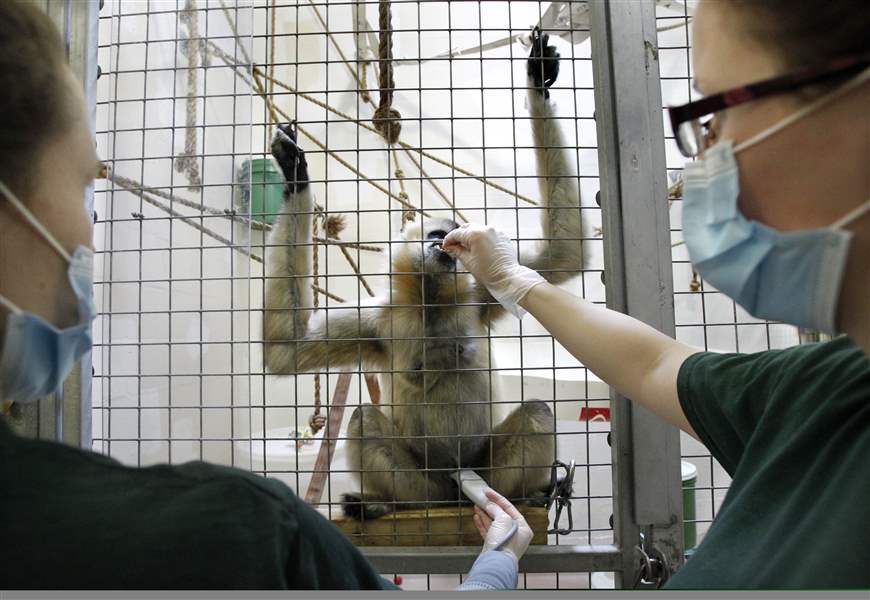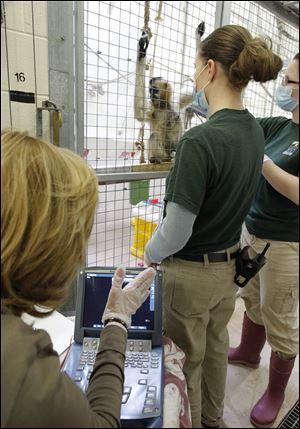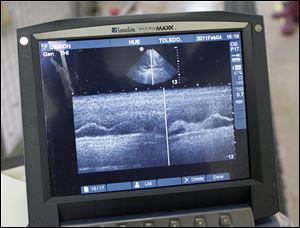
Patients in training: Zoo animals learn to undergo medical procedures
4/10/2011
Katie Clifton, left, holds an ultrasound transducer on a gibbon named Hue, as Koral Stoddard keeps her occupied with treats during an ultrasound procedure at the Toledo Zoo..
The Blade/Dave Zapotosky
Buy This Image

Katie Clifton, left, holds an ultrasound transducer on a gibbon named Hue, as Koral Stoddard keeps her occupied with treats during an ultrasound procedure at the Toledo Zoo..
When 19-year-old Hue needs an ultrasound examination it's not all that different from any other woman allowing doctors to take a peek at her insides.
Except it's safe to say the typical woman doesn't sit on a platform behind mesh wire, absent-mindedly fiddling with silver metal clips during the procedure. And she isn't fed grapes and told what a "good girl" she is. Oh, and her husband and kids probably don't hang around watching either.
OK, OK, so it's nothing like any other woman getting an ultrasound, but that's because Hue is a gibbon at the Toledo Zoo. While the medical procedure features all the usual stuff you'd expect from an ultrasound — lots of soft talking and maneuvering the examination wand across the patient's belly while a technician stares at a black-and-white screen — things are definitely different when the patient is a smallish member of the ape family.
Hue's procedure was a routine part of the zoo's ongoing program to train the various animals to undergo medical exams such as teeth inspections, injections, and ultrasounds so they're accustomed to it when the time comes for the real deal. Veterinary care at the zoo is a complicated, never-ending process and the better trained the animals are for the routine stuff, the safer it is for them and their handlers.
After all, do you want to be the person trying to give a cranky, scared gibbon the first ultrasound of her life when she's already pregnant?
Training, training, training
The procedure with Hue went so smoothly it was anti-climactic. She placidly accepted grapes from zoo keeper Koral Stoddard while keeper Katie Clifton maneuvered the ultrasound wand over her belly. A few feet away Connie Warner, an ultrasound technologist, stared at the screen and directed Ms. Clifton.

Connie Warner, a registered ultrasound technician who volunteers at the Toledo Zoo, left, directs Katie Clifton, as she holds an ultrasound transducer on a gibbon.
Gibbons are monogamous and they live as family units, so Hue's "husband" Batu looked on and her other offspring played and wandered around in the large, indoor enclosure where they spend much of their time in the winter months, never taking their eyes off the family matriarch. The female gibbon sat on a small platform — her "station" — and maintained an air of curious calm.
"Hue is the boss. She wears the pants in this family," Ms. Clifton said as the procedure wrapped up.
The procedures aren't always so sedate, said the zoo's chief veterinarian, Chris Hanley.
"That's a process of two years [of training]," he said later. "It can take months just to get them to the station."
The only purpose of the 20-minute procedure was to work with Hue and keep her training up to speed because she's already on ape birth control. The goal is to ensure she's used to the monitoring so that when she is pregnant the progress of her fetus can be measured without incident.
Lots of patience
The training the animals undergo — whether it's a big cat or a small ape — is strikingly similar to basic dog training. The keepers use incentives — mostly food treats — to teach them certain behaviors and it can take years.
Food is usually used to lure the animal to its station — generally next to the side of the mesh enclosure — and then the animal can be taught to open its mouth for an important tooth inspection, move up to the side and stand still for a shot, or even allow an ultrasound.
Patience is a requirement because each animal has "stall points" where it might not want to do what the vet and his keepers want. Plus, they're dealing with creatures that might be in a bad mood, not feeling well, or who are extra stubborn on a particular day (no doubt dog owners can relate). The key is to look for a little success — such as getting the animal to sit at its station for just one treat — and then come back another day and start over.
"You just don't want to have a negative experience that sets back the process," Mr. Hanley said.
‘Is this normal?'
The benefits of the program are obvious in terms of improving health care for the patients. Mr. Hanley said just being able to inspect an animal's teeth can go a long way toward better care. For example, if a lion isn't eating as much as usual, rather than automatically have to anesthetize her and check her internal organs, the problem might be as simple as a broken tooth, which Mr. Hanley can determine relatively quickly.

An image from a recent ultrasound performed on Hue, a gibbon at the Toledo Zoo, is seen on a computer screen.
Ms. Warner has been doing ultrasounds at the zoo on a volunteer basis since 1999. A registered ultrasonographer, she works at Westfield OB-GYN Association in Toledo, and she said the learning curve for her isn't quite as steep as you might think.
"Most of the animals I work on at the zoo are mammals and you and I are mammals and the anatomy — because we are mammals — is almost identical to ours," she said.
Mr. Hanley said various zoos are building and sharing information on what they learn from ultrasounds and inspections so they better understand wild animals. He said 75 percent of male gorillas in captivity suffer from heart disease. So every male gorilla at the zoo has a heart ultrasound so his condition can be monitored.
But there are still some mysteries that crop up because the processes are relatively new.
"Myself included, we're all still learning," he said. "[Ms. Warner] will say, ‘Hey is this normal?' and I say, ‘Connie, do you know how many cheetah bladders I've ultrasounded?'"
Contact Rod Lockwood at rlockwood@theblade.com or 419-724-6159.